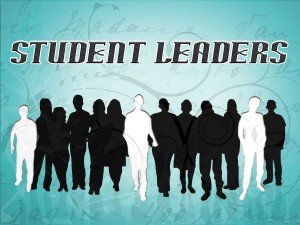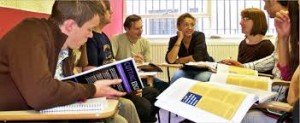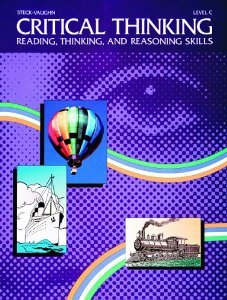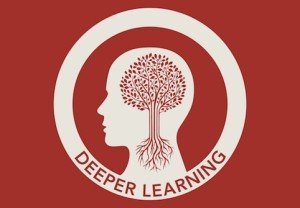Teaching Platform Articles
K12 Learning and Teaching Platforms
HOW TO GET A JOB AT GOOGLE
By THOMAS FRIEDMAN
2/25/2014
Santa Rosa Press Democrat
MOUNTAIN VIEW Last June, in an interview with Adam Bryant of the New York Times, Laszlo Bock, the senior vice president of people operations for Google — i.e., the guy in charge of hiring for one of the world’s most successful companies — noted that Google had determined that “GPAs are worthless as a criteria for hiring, and test scores are worthless. . . . We found that they don’t predict anything.”
He also noted that the “proportion of people without any college education at Google has increased over time” — now as high as 14 percent on some teams. At a time when many people are asking, “How’s my kid gonna get a job?” I thought it would be useful to visit Google and hear how Bock would answer.
Don’t get him wrong, Bock begins, “Good grades certainly don’t hurt.” Many jobs at Google require math, computing and coding skills, so if your good grades truly reflect skills in those areas that you can apply, it would be an advantage. But Google has its eyes on much more.
“There are five hiring attributes we have across the company,” explained Bock. “If it’s a technical role, we assess your coding ability, and half the roles in the company are technical roles. For every job, though, the No. 1 thing we look for is general cognitive ability, and it’s not IQ. It’s learning ability. It’s the ability to process on the fly. It’s the ability to pull together disparate bits of information. We assess those using structured behavioral interviews that we validate to make sure they’re predictive.”
The second, he added, “is leadership — in particular emergent leadership as opposed to traditional leadership. Traditional leadership is, were you president of the chess club? Were you vice president of sales? How quickly did you get there? We don’t care. What we care about is, when faced with a problem and you’re a member of a team, do you, at the appropriate time, step in and lead. And just as critically, do you step back and stop leading, do you let someone else? Because what’s critical to be an effective leader in this environment is you have to be willing to relinquish power.”
What else? Humility and ownership. “It’s feeling the sense of responsibility, the sense of ownership, to step in,” he said, to try to solve any problem — and the humility to step back and embrace the better ideas of others. “Your end goal,” explained Bock, “is what can we do together to problem-solve? I’ve contributed my piece, and then I step back.’ And it is not just humility in creating space for others to contribute, says Bock, it’s “intellectual humility. Without humility, you are unable to learn.” It is why research shows that many graduates from hotshot business schools plateau. “Successful bright people rarely experience failure, and so they don’t learn how to learn from that failure,” Bock said.
“They, instead, commit the fundamental attribution error, which is if something good happens, it’s because I’m a genius. If something bad happens, it’s because someone’s an idiot or I didn’t get the resources or the market moved. . . . What we’ve seen is that the people who are the most successful here, who we want to hire, will have a fierce position. They’ll argue like hell. They’ll be zealots about their point of view. But then you say, ‘here’s a new fact,’ and they’ll go, ‘Oh, well, that changes things; you’re right.’ ” You need a big ego and small ego in the same person at the same time.
The least important attribute they look for is “expertise.” Said Bock: “If you take somebody who has high cognitive ability, is innately curious, willing to learn and has emergent leadership skills, and you hire them as an HR person or finance person, and they have no content knowledge, and you compare them with someone who’s been doing just one thing and is a world expert, the expert will go: ‘I’ve seen this 100 times before; here’s what you do.” Most of the time the non-expert will come up with the same answer, added Bock, “because most of the time it’s not that hard.”
Sure, once in a while they will mess it up, he said, but once in a while they’ll also come up with an answer that is totally new. And there is huge value in that.
To sum up Bock’s approach to hiring: Today, talent can come in so many different forms and be built in so many nontraditional ways, hiring officers have to be alive to every one — besides brand-name colleges. “Because when you look at people who don’t go to school and make their way in the world, those are exceptional human beings. And we should do everything we can to find those people.”
Too many colleges, he added, “don’t deliver on what they promise. You generate a ton of debt; you don’t learn the most useful things for your life. It’s just an extended adolescence.”
Google attracts so much talent it can afford to look beyond traditional metrics, like GPA. For most young people, though, going to college and doing well is still the best way to master the tools needed for many careers. But Bock is saying something important to them, too: Beware. Your degree is not a proxy for your ability to do any job. The world only cares about — and pays off on — what you can do with what you know (and it doesn’t care how you learned it). And in an age when innovation is increasingly a group endeavor, it also cares about a lot of soft skills — leadership, humility, collaboration, adaptability and loving to learn and re-learn. This will be true no matter where you go to work. Thomas Friedman is a columnist for the New York Times.
FINDING TEAM PLAYERS IN IPOD AGE
By Paul Gullixson
Santa Rosa Press Democrat
2/23/2014
How is it that a county can be suffering from both high unemployment and a labor shortage?
It’s not clear, but the consensus of the speakers at Wednesday’s Economic Outlook Conference at Sonoma State University is that this is where Sonoma County finds itself.
Although the county unemployment rate recently dropped below 6 percent for the first time in nearly six years, numerous locals are still looking for work while many North Bay companies are looking to fill positions — and both are having a find time finding what they need.
Craig Nelson, chairman of the board of the Nelson Family of Companies, one of the largest employment service companies in Northern California, said his firm has often had problems finding highly skilled workers to fill job openings. But now they’re having troubles filling all positions in the North Bay, including administrative assistants and production workers.
“In some cases, we are going out and finding people who already have jobs,” said Nelson, a panelist in a session on this region’s future workforce. “I don’t know what the issue is, but this is across the board.”
Whatever is happening, the panelists appeared to agree that the solution is to be found in local education systems.
Matt Cooper, vice president of business development for oDesk — a company that creates online workspace accessible by individuals in remote locations — said his company did a study on the work expectations of those coming out of college. They found a significant gap between what graduates anticipated their work life would be like — including the expectation that they would be running their own companies in four years — and reality.
Many also are emerging without basic skills they need for today’s workplace. Those seeking a high-end job need not only to have developed computational thinking, but they need to have a certain level of persistence, he said.
“What I see are more graduates coming out who have never had to struggle,” Cooper said. In an age of helicopter parents, some emerge without having learned the art of failing, a fundamental component in what gives the Bay Area its economic edge on the rest of the world — innovation.’
Employers are looking for individuals who not only have the hard skill sets needed to be an engineer or software developer but have the “soft skills” in knowing how to present an idea, make a well-reasoned argument and sell themselves.
Cooper said there’s no shortage of book-smart job candidates in the Bay Area. “But,” he asked, “how many of them would you actually put in front of a customer?”
All of this exposes the gaps in our current education system that prevent graduates from being ready for this work environment.
By encouraging internships and other partnerships with private industry, colleges such as Sonoma State are clearly trying to bridge these gaps. And based on what I’m seeing through the experiences of my kids, ages 11 and 14, local schools are trying to do the same. More K-12 schools are offering a variety programs such as Odyssey of the Mind, robotics and Academic Decathlon that encourage collaboration, creative thinking and problem- solving. But most are offered only as afterschool programs that receive little financial support from the school districts themselves. In most cases, support depends heavily on parents who may not be in a position to write the checks that are needed.
The good news is that collaboration, critical thinking and problem solving are key components of the new Common Core curriculum and standards, which will be taking effect in California this year. It sounds good.
But I’m still not sold on the idea that the burden is solely on education to fix this. There’s something going on in our personal lives that’s contributing to this problem.
It seems to me Silicon Valley is guilty of creating products that contribute to the isolationism that inhibits the development of skills those very employers say they want and need. How is that? Observe any group of young people. You’ll be hard pressed not to see one, possibly all, laser-focused on iPods, smartphones, iPads, etc. even as they ostensibly “hang out.” To be honest, the same is true of some adult groups.
We work alone. We listen alone. We watch TV alone. In some cases, our sense of community comes more from Facebook than family.
Should we really be surprised that employers are having a hard time finding, and educators are having trouble developing, a workforce that knows how to work in teams?
It’s something else we need to about it — without our earbuds.
EDUCATION NEEDS TO BE RETOOLED AS WELL
By MICHAEL HARAN
Published: Press Democrat; Friday, April 19, 2013 at 7:31pm
After reading Andy Brennan and Simone Harris’ Close to Home article (A teacher’s perspective on improved learning PD 4/4/13) and Bill Gates article (Here’s a fairer way to evaluate teachers PD 4/5/13) on teacher evaluation neither article addressed the new curriculums that are now being developed by K-12 textbook and eBook publishers and the evolution of K-12 teaching methods.
Under Obama’s Race to the Top states are required to meet three main educational criteria: adoption of rigorous academic achievement standards; a program to focus on turning around low performing schools; and the most contentious provision, an accountability system that would involve using test scores to evaluate teachers and principals.
In 2010, California became one of 45 states to adopt the new Common Core State Standards (CCSS) Initiative to meet these criteria and the transition is now under way. Assessments aligned with the standards are also being developed and are expected to be in place for the 2014-15 school year, replacing the STAR tests. The new standards and skill requirements have been developed with the goal of creating consistency across the country.
The California Legislature in March 2011 suspended the adoption of instructional materials until the 2014–15 school year. This was due partially to budget cuts but also to allow time for publishers to adapt instruction materials to the Common Core State Standards (CCSS).
Just like a good race car mechanic a teacher needs sound methodology and precision tools to be successful. Anyone who studies K-12 education knows that the industry has long needed a makeover. Everything evolves and we are now watching an evolution in teaching structure. Many school districts are experimenting with, if not outright adopting, the progressive teaching/learning model called “Flipping the Classroom.”
In flip teaching, the student first studies the topic by himself, typically using video lessons created by the instructor or those provided by an Open Education Recourse (OER), such as the Khan Academy. In the classroom, the pupil then tries to apply the knowledge by solving problems and doing practical applications. The role of the classroom teacher is then to tutor the student when they become stuck, rather than to impart the initial lesson. This allows time inside the class to be used for additional activities, including use of “differentiated instruction” which is more student specific and “project-based learning” which is the practical application.
In another progressive teaching/learning model North Carolina State University College of Education has developed program which they call the FIZZ concept. With this program students video themselves reciting a lesson. The object is to allow students to revisit the video to evaluate and analyze not only what they have learned but also what their peers have learned. The objective is to give the student “ownership” of the lesson which they call the highest level of learning.
Along with the evolution of teaching methodology the next generation of K-12 instruction materials needs to be written to align to these and other progressive teaching models. The publishers now have an opportunity to incorporate modern learning technology with the four predominate student learning styles which are: Linguistic (“word smart” they learn by writing and reading); Logical-mathematical (“number/reasoning smart) Spatial (“picture smart” they learn from images); Bodily-Kinesthetic (“body smart” they need to be moving to learn). I think “Bodily-Kinesthetic learners are many times misdiagnosed with having ADD.
If you want to increase test scores give teachers curriculum that develops the coveted goals of critical thinking, collaboration and communication in all students. You can’t win the race without the right tools.
Michael Haran is research director for the Institute of Progressive Education and Learning.
RIGOR REDEFINED
Even our “best” schools are failing to prepare students for 21st-century careers and citizenship.
© Tony Wagner, 2008 (first published in Educational Leadership, October, 2008)
In the new global economy, with many jobs being either automated or “off-shored,” what skills will students need to build successful careers? What skills will they need to be good citizens? Are these two education goals in conflict?
To examine these questions, I conducted research beginning with conversations with several hundred business, nonprofit, philanthropic, and education leaders. With a clearer picture of the skills young people need, I then set out to learn whether U.S. schools are teaching and testing the skills that matter most. I observed classrooms in some of the nation’s most highly regarded suburban schools to find out whether our “best” was, in fact, good enough for our children’s future. What I discovered on this journey may surprise you.
The Schooling Students Need
 One of my first conversations was with Clay Parker, president of the Chemical Management Division of BOC Edwards—a company that, among other things, makes machines and supplies chemicals for the manufacture of microelectronics devices. He’s an engineer by training and the head of a technical business, so when I asked him about the skills he looks for when he hires young people. I was taken aback by his answer.
One of my first conversations was with Clay Parker, president of the Chemical Management Division of BOC Edwards—a company that, among other things, makes machines and supplies chemicals for the manufacture of microelectronics devices. He’s an engineer by training and the head of a technical business, so when I asked him about the skills he looks for when he hires young people. I was taken aback by his answer.
“First and foremost, I look for someone who asks good questions,” Parker responded. “We can teach them the technical stuff, but we can’t teach them how to ask good questions—how to think.”
“What other skills are you looking for?” I asked, expecting that he’d jump quickly to content expertise.
“I want people who can engage in good discussion—who can look me in the eye and have a give and take. All of our work is done in teams. You have to know how to work well with others. But you also have to know how to engage customers—to find out what their needs are. If you can’t engage others, then you won’t learn what you need to know.”
I initially doubted whether Parker’s views were representative of business leaders in general. But after interviewing leaders in settings from Apple to Unilever to the U.S. Army and reviewing the research on workplace skills, I came to understand that the world of work has changed profoundly.
Today’s students need to master seven survival skills to thrive in the new world of work. And these skills are the same ones that will enable students to become productive citizens who contribute to solving some of the most pressing issues we face in the 21st century.
1. Critical Thinking and Problem Solving
To compete in the new global economy, companies need their workers to think about how to continuously improve their products, processes, or services. Over and over, executives told  me that the heart of critical thinking and problem solving is the ability to ask the right questions. As one senior executive from Dell said, “Yesterday’s answers won’t solve today’s problems.”
me that the heart of critical thinking and problem solving is the ability to ask the right questions. As one senior executive from Dell said, “Yesterday’s answers won’t solve today’s problems.”
Ellen Kumata, managing partner at Cambria Associates, explained the extraordinary pressures on leaders today. “The challenge is this: How do you do things that haven’t been done before, where you have to rethink or think anew? It’s not incremental improvement any more. The markets are changing too fast.”
2. Collaboration and Leadership
Teamwork is no longer just about working with others in your building. Christie Pedra, CEO of Siemens, explained, “Technology has allowed for virtual teams. We have teams working on major infrastructure projects that are all over the U.S. On other projects, you’re working with people all around the world on solving a software problem. Every week they’re on a variety of conference calls; they’re doing Web casts; they’re doing net meetings.”
Mike Summers, vice president for Global Talent Management at Dell, said that his greatest concern was young people’s lack of leadership skills. “Kids just out of school have an amazing lack of preparedness in general leadership skills and collaborative skills,” he explained. “They lack the ability to influence.”
3. Agility and Adaptability
Clay Parker explained that anyone who works at BOC Edwards today “has to think, be flexible, change, and use a variety of tools to solve new problems. We change what we do all the time. I can guarantee the job I hire someone to do will change or may not exist in the future, so this is why adaptability and learning skills are more important than technical skills.”
4. Initiative and Entrepreneurialism
Mark Chandler, senior vice president and general counsel at Cisco, was one of the strongest proponents of initiative: “I say to my employees, if you try five things and get all five of them right, you may be failing. If you try 10 things, and get eight of them right, you’re a hero. You’ll never be blamed for failing to reach a stretch goal, but you will be blamed for not trying. One of the problems of a large company is risk aversion. Our challenge is how to create an entrepreneurial culture in a larger organization.”
5. Effective Oral and Written Communication
Mike Summers of Dell said, “We are routinely surprised at the difficulty some young people have in communicating: verbal skills, written skills, presentation skills. They have difficulty being clear and concise; it’s hard for them to create focus, energy, and passion around the points they want to make. If you’re talking to an exec, the first thing you’ll get asked if you  haven’t made it perfectly clear in the first 60 seconds of your presentation is, ‘What do you want me to take away from this meeting?’ They don’t know how to answer that question.”
haven’t made it perfectly clear in the first 60 seconds of your presentation is, ‘What do you want me to take away from this meeting?’ They don’t know how to answer that question.”
Summers and other leaders from various companies were not necessarily complaining about young people’s poor grammar, punctuation, or spelling—the things we spend so much time teaching and testing in our schools. Although writing and speaking correctly are obviously important, the complaints I heard most frequently were about fuzzy thinking and young people not knowing how to write with a real voice.
6. Accessing and Analyzing Information
Employees in the 21st century have to manage an astronomical amount of information daily. As Mike Summers told me, “There is so much information available that it is almost too much, and if people aren’t prepared to process the information effectively it almost freezes them in their steps.”
It’s not only the sheer quantity of information that represents a challenge, but also how rapidly the information is changing. Quick—how many planets are there? In the early 1990s, I heard then–Harvard University president Neil Rudenstine say in a speech that the half-life of knowledge in the humanities is 10 years, and in math and science, it’s only two or three  years. I wonder what he would say it is today.
years. I wonder what he would say it is today.
7. Curiosity and Imagination
Mike Summers told me, “People who’ve learned to ask great questions and have learned to be inquisitive are the ones who move the fastest in our environment because they solve the biggest problems in ways that have the most impact on innovation.”
Daniel Pink, the author of “A Whole New Mind,” observes that with increasing abundance, people want unique products and services: “For businesses it’s no longer enough to create a product that’s reasonably priced and adequately functional. It must also be beautiful, unique, and meaningful.” Pink notes that developing young people’s capacities for imagination, creativity, and empathy will be increasingly important for maintaining the United States’ competitive advantage in the future.
The Schooling Students Get
I’ve spent time observing in classrooms across the United States for more than 20 years. Here is a sampling of what I’ve seen recently. These examples come from secondary honors and advanced placement (AP) classes in three school systems that enjoy excellent reputations because of their high test scores.
AP Chemistry
Students work in groups of two and three mixing chemicals according to directions written on the chalkboard. Once the mixtures are prepared, students heat the concoction with Bunsen burners. According to the directions on the board, they are supposed to record their observations on a worksheet.
Bunsen burners. According to the directions on the board, they are supposed to record their observations on a worksheet.
I watch a group of three young men whose mixture is giving off a thin spiral of smoke as it’s being heated—something that none of the other students’ beakers are doing. One student looks back at the chalkboard and then at his notes. Then all three stop what they are doing, apparently waiting for the teacher to come help them.
“What’s happening to your mixture?” I ask the group.
“Dunno,” one mutters. “We must have mixed it up wrong.”
“What’s your hypothesis about what happened—why it’s smoking?”
The three look at one another blankly, and the student who has been doing all the speaking looks at me and shrugs.
AP U.S. Government
The teacher is reviewing answers to a sample test that the class took the previous day. The test contains 80 multiple-choice questions related to the functions and branches of the federal government.
When he’s finished, he says “OK, now let’s look at some sample free-response questions from previous years’ AP exams.” He flips the overhead projector on and reads from the text of a transparency: “Give three reasons why the Iron Triangle may be criticized as undemocratic. How would you answer this question?”
No one replies.
“OK, who can give me a definition of the Iron Triangle?”
A student pipes up, “The military-industrial-congressional complex.”
“OK, so what would be three reasons why it would be considered undemocratic?” The teacher calls on a student in the front row who has his hand half raised, and he answers the question in a voice that we can’t hear over the hum of the projector’s fan.
“Good. Now let’s look at another one.” The teacher flips another transparency onto the projector. “Now this question is about bureaucracy. Let me tell you how to answer this one. . . .”
AP English
The teacher explains that the class is going to review students’ literature notes for the advanced placement exam next week. The seven students are deeply slouched in their chairs, arranged in a semicircle around the teacher’s desk.
The teacher asks, “Now what is Virginia Woolf saying about the balance between an independent life versus a social life?”
Students ruffle through their notebooks. Finally, a young woman, reading from her notes, answers, “Mrs. Ramsey sought meaning from social interactions.”
“Yes, that’s right. Now what about Lily, the artist? How did she construct meaning?”
“Through her painting,” another student mumbles, her face scrunched close to her notes.
“So what is Woolf saying about the choices these two women have made, and what each has sacrificed?”
No reply. The teacher sighs, gets up, goes to the board, and begins writing.
A Rare Class
Once in a great while, I observe a class in which a teacher is using academic content to develop students’ core competencies. In such a class, the contrast with the others is stark.
At the beginning of the period in an Algebra II class, the teacher writes a problem on the board. He turns to the students, who are sitting in desks arranged in squares of four that face one another. “You haven’t seen this kind of problem before,” he explains. “Solving it will require you to use concepts from both geometry and algebra. Each group will try to develop at least two different ways to solve this problem. After all the groups have finished, I’ll randomly choose someone from each group who will write one of your proofs on the board, and I’ll ask that person to explain the process your group used.”
The groups quickly go to work. Animated discussion takes place as students pull the problem apart and talk about different ways to solve it. While they work, the teacher circulates from group to group. When a student asks a question, the teacher responds with another question: “Have you considered . . .?” “Why did you assume that?” or simply “Have you asked someone in your group?”
What makes this an effective lesson—a lesson in which students are learning a number of the seven survival skills while also mastering academic content? First, students are given a complex, multi-step problem that is different from any they’ve seen in the past. To solve it, they have to apply critical-thinking and problem-solving skills and call on previously acquired knowledge from both geometry and algebra. Mere memorization won’t get them far. Second, they have to find two ways to solve the problem, which requires initiative and imagination. Third, they have to explain their proofs using effective communication skills. Fourth, the teacher does not spoon-feed students the answers. He uses questions to push students’ thinking and build their tolerance for ambiguity. Finally, because the teacher announces in advance that he’ll randomly call on a student to show how the group solved the problem, each student in every group is held accountable. Success requires teamwork.
Rigor for the 21st Century
Across the United States, I see schools that are succeeding at making adequate yearly progress but failing our students. Increasingly, there is only one curriculum: test prep. Of the hundreds of classes that I’ve observed in recent years, less than 1 in 20 were engaged in instruction designed to teach students to think instead of merely drilling for the test.
To teach and test the skills that our students need, we must first redefine excellent instruction. It is not a checklist of teacher behaviors and a model lesson that covers content standards. It is working with colleagues to ensure that all students master the skills they need to succeed as lifelong learners, workers, and citizens. I have yet to talk to a recent graduate, college teacher, community leader, or business leader who said that not knowing enough academic content was a problem. In my interviews, everyone stressed the importance of critical thinking, communication skills, and collaboration.
We need to use academic content to teach the seven survival skills every day, at every grade level, and in every class. And we need to insist on a combination of locally developed assessments and new nationally normed, online tests—such as the College and Work Readiness Assessment — that measure students’ analytic-reasoning, critical-thinking, problem-solving, and writing skills.
It’s time to hold ourselves and all of our students to a new and higher standard of rigor, defined according to 21st-century criteria. It’s time for our profession to advocate for accountability systems that will enable us to teach and test the skills that matter most. Our students’ futures are at stake.
Tony Wagner is Codirect of the Change Leadership Group at the Harvard Graduate School of Education; The themes of this article are discussed more fully in his book “The Global Achievement Gap: Why Even Our Best Schools Don’t Teach the New Survival Skills Our Children Need—and What We Can Do About It” (Basic Books, 2008).
NASBE INITIATIVE DELVES INTO DEEPER LEARNING
SOURCE National Association of State Boards of Education
ARLINGTON, Va., April 1, 2013 /PRNewswire-USNewswire/ — A rapidly changing world necessitates education adapt at an equally swift pace, as students need to be equipped with an ever-broadening knowledge base to prepare them for their post-K-12 lives. The National Association of State Boards of Education (NASBE) is embarking on an effort to go beyond policies that expand the breadth of learning to help state boards to encourage explore deeper learning. This three-year project to encourage such policies is supported with an approximately $774,000grant from The William and Flora Hewlett Foundation.
To accomplish this, NASBE will work with state-level education policymakers by raising their awareness of the need for deeper learning in preparing students to be college and career-ready and by creating a national coalition partnership to serve as an expert think tank especially focused on state level policy and deeper learning, among other actions.
“Deeper learning is an essential ingredient to education,” said NASBE Interim Executive Director Brad Hull. “Global competitiveness, technological advances, and momentous issues for the human family are increasing exponentially. Expertise in critical thinking, problem solving, effective communication, collaboration, and self-awareness will be essential to survive and thrive as we move through the 21st century. These skills must be learned throughout a lifetime and begun at an early age.”
Through the length of the grant, NASBE will also build policymaker skills to help them better understand deeper learning and apply that learning to their policymaking, especially regarding assessment, accountability, teacher professional development, curriculum and instructional methods. To assist boards with this, NASBE will produce a deeper learning discussion guide, host conference calls and webinars, and sessions at its annual conferences.
Further, NASBE will award grants to six states during the project’s first two years with the intent of raising the visibility of deeper learning as an issue in each state, as well as capacity building. Additionally, NASBE staff and subject-matter experts will conduct in-state policy workshops in each state that receives a grant.
The National Association of State Boards of Education represents America’s state and territorial boards of education. NASBE exists to strengthen state boards as the preeminent educational policymaking bodies for citizens and students. For more, visit www.nasbe.org.
©2012 PR Newswire. All Rights Reserved.
NEED A JOB? INVENT IT
Published: March 30, 2013
WHEN Tony Wagner, the Harvard education specialist, describes his job today, he says he’s “a translator between two hostile tribes” — the education world and the business world, the people who teach our kids and the people who give them jobs. Wagner’s argument in his book “Creating Innovators: The Making of Young People Who Will Change the World” is that our K-12 and college tracks are not consistently “adding the value and teaching the skills that matter most in the marketplace.”
This is dangerous at a time when there is increasingly no such thing as a high-wage, middle-skilled job — the thing that sustained the middle class in the last generation. Now there is only a high-wage, high-skilled job. Every middle-class job today is being pulled up, out or down faster than ever. That is, it either requires more skill or can be done by more people around the world or is being buried — made obsolete — faster than ever. Which is why the goal of education today, argues Wagner, should not be to make every child “college ready” but “innovation ready” — ready to add value to whatever they do.
That is a tall task. I tracked Wagner down and asked him to elaborate. “Today,” he said via e-mail, “because knowledge is available on every Internet-connected device, what you know matters far less than what you can do with what you know. The capacity to innovate, the ability to solve problems creatively or bring new possibilities to life — and skills like critical thinking, communication and collaboration are far more important than academic knowledge. As one executive told me, ‘We can teach new hires the content, and we will have to because it continues to change, but we can’t teach them how to think — to ask the right questions — and to take initiative.’ ”
My generation had it easy. We got to “find” a job. But, more than ever, our kids will have to “invent” a job. (Fortunately, in today’s world, that’s easier and cheaper than ever before.) Sure, the lucky ones will find their first job, but, given the pace of change today, even they will have to reinvent, re-engineer and reimagine that job much more often than their parents if they want to advance in it. If that’s true, I asked Wagner, what do young people need to know today?
“Every young person will continue to need basic knowledge, of course,” he said. “But they will need skills and motivation even more. Of these three education goals, motivation is the most critical. Young people who are intrinsically motivated, curious, persistent, and willing to take risks — will learn new knowledge and skills continuously. They will be able to find new opportunities or create their own — a disposition that will be increasingly important as many traditional careers disappear.”
So what should be the focus of education reform today? “We teach and test things most students have no interest in and will never need, and facts that they can Google and will forget as soon as the test is over,” said Wagner. “Because of this, the longer kids are in school, the less motivated they become. Gallup’s recent survey showed student engagement going from 80 percent in fifth grade to 40 percent in high school. More than a century ago, we ‘reinvented’ the one-room schoolhouse and created factory schools for the industrial economy.
Reimagining schools for the 21st-century must be our highest priority. We need to focus more on teaching the skill and will to learn and to make a difference and bring the three most powerful ingredients of intrinsic motivation into the classroom: play, passion and purpose.”
What does that mean for teachers and principals? “Teachers,” he said, “need to coach students to performance excellence, and principals must be instructional leaders who create the culture of collaboration required to innovate. But what gets tested is what gets taught, and so we need ‘Accountability 2.0.’ All students should have digital portfolios to show evidence of mastery of skills like critical thinking and communication, which they build up right through K-12 and postsecondary. Selective use of high-quality tests, like the College and Work Readiness Assessment, is important. Finally, teachers should be judged on evidence of improvement in students’ work through the year — instead of a score on a bubble test in May. We need lab schools where students earn a high school diploma by completing a series of skill-based ‘merit badges’ in things like entrepreneurship. And schools of education where all new teachers have ‘residencies’ with master teachers and performance standards — not content standards — must become the new normal throughout the system.”
Who is doing it right? “Finland is one of the most innovative economies in the world,” he said, “and it is the only country where students leave high school ‘innovation-ready.’ They learn concepts and creativity more than facts, and have a choice of many electives — all with a shorter school day, little homework, and almost no testing. In the U.S., 500 K-12 schools affiliated with Hewlett Foundation’s Deeper Learning Initiative and a consortium of 100 school districts called EdLeader21 are developing new approaches to teaching 21st-century skills. There are also a growing number of ‘reinvented’ colleges like the Olin College of Engineering, the M.I.T. Media Lab and the ‘D-school’ at Stanford where students learn to innovate.”
THE REAL REASON NEW COLLEGE GRADS CAN’T GET HIRED
Time – 11/10/2013
It’s because college kids today can’t do math, one line of reasoning goes. Or they don’t know science. Or they’re clueless about technology, aside from their myriad social-media profiles. These are all good theories, but the problem with the unemployability of these young adults goes way beyond a lack of STEM skills. As it turns out, they can’t even show up on time in a button-down shirt and organize a team project.
The technical term for navigating a workplace effectively might be soft skills, but employers are facing some hard facts: the entry-level candidates who are on tap to join the ranks of full-time work are clueless about the fundamentals of office life.
A survey by the Workforce Solutions Group at St. Louis Community College finds that more than 60% of employers say applicants lack “communication and interpersonal skills” — a jump of about 10 percentage points in just two years. A wide margin of managers also say today’s applicants can’t think critically and creatively, solve problems or write well.
Another employer survey, this one by staffing company Adecco, turns up similar results. The company says in a statement, “44% of respondents cited soft skills, such as communication, critical thinking, creativity and collaboration, as the area with the biggest gap.” Only half as many say a lack of technical skills is the pain point.
As much as academics go on about the lack of math and science skills, bosses are more concerned with organizational and interpersonal proficiency. The National Association of Colleges and Employers surveyed more than 200 employers about their top 10 priorities in new hires. Overwhelmingly, they want candidates who are team players, problem solvers and can plan, organize and prioritize their work. Technical and computer-related know-how placed much further down the list.
Jobs are going unfilled as a result, which hurts companies and employees. The annual global Talent Shortage Survey from Manpower Group finds that nearly 1 in 5 employers worldwide can’t fill positions because they can’t find people with soft skills. Specifically, companies say candidates are lacking in motivation, interpersonal skills, appearance, punctuality and flexibility.
One thing that does appear to make a difference is internships, according to a Harris Interactive survey of more than 2,000 college students and 1,000 hiring managers on behalf of textbook company Chegg: more than 80% of employers want new grads they hire to have completed a formal internship, but only 8% of students say interning in a field related to their major is something they spend a lot of time doing. Instead, the top extracurricular activities are hanging out with friends, working in an unrelated job and eating out.
 And all internships are not created equal. Overall, only about half of college grads say they’re prepared for the workplace — and the number of bosses who think they’re prepared is lower than 40%. Among students who don’t intern, only 44% consider themselves ready for the job market. That improves for students with unpaid internships; 58% say they’re prepared for the workplace. But among students who complete paid internships that number jumps to 70%.
And all internships are not created equal. Overall, only about half of college grads say they’re prepared for the workplace — and the number of bosses who think they’re prepared is lower than 40%. Among students who don’t intern, only 44% consider themselves ready for the job market. That improves for students with unpaid internships; 58% say they’re prepared for the workplace. But among students who complete paid internships that number jumps to 70%.
Part of the problem is that you don’t know what you don’t know, as the saying goes. Harris Interactive found a huge gap between students’ perceptions of their abilities and managers’ perceptions of those same skills. None of the students think they’re entirely prepared for the workforce, but they’re a lot more confident than the managers surveyed. There’s a 22-percentage-point difference between the two groups’ assessment of the students’ financial skills, which Inside Higher Ed calls “alarming,” in an article about the research. Managers also take a much dimmer view of students’ abilities to communicate with authority figures, prioritize and organize their work, manage projects, work in teams and with diverse groups.
It’s just harder to teach these skills, experts say. “It is hard to correct a lifetime of bad habits in a short period of time,” Roderick Nunn, vice chancellor for economic development and workforce solutions at St. Louis Community College, tells the St. Louis Beacon.

Recent Comments